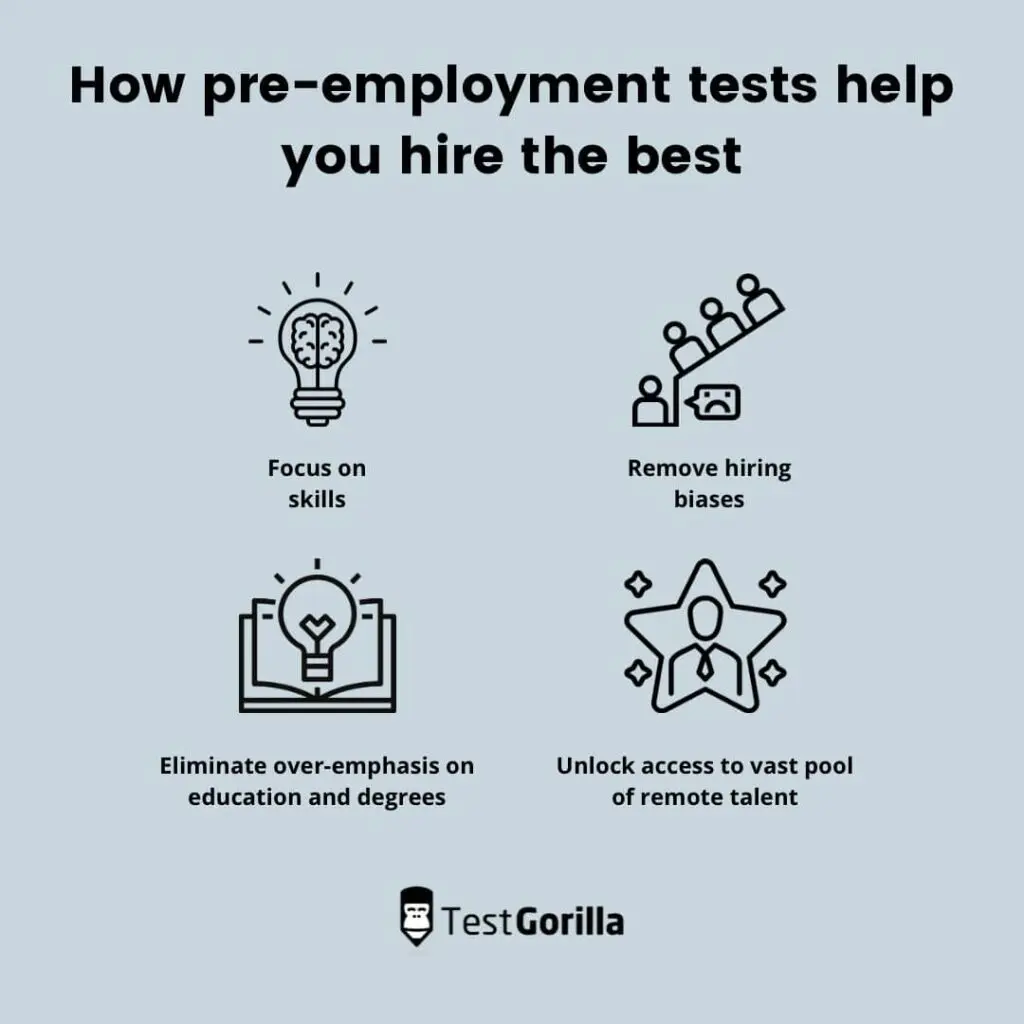The foundation of computer science lies in algorithms and data structures. To vet and hire the best developers, it is important for you, as a hiring manager, to ask the correct set of data structure questions to your prospective candidates.
This holds true for Python developers, too.
In this blog post, we will cover a comprehensive list of Python data structures interview questions involving essential theoretical concepts and problem-solving methods that you can include in your next Python developer interview.
Table of contents
20 basic Python data structures interview questions and the answers
What are data structures?
Definition, storage, and retrieval of data using a structured & systematic framework is what data structures are all about. Different types of data can be stored in a data structure.
2. What are the various data structures available?
The commonly used data structures include lists, arrays, stacks, queues, graphs, trees, etc.
3. What is a linear data structure?
Linear data structures have sequentially arranged data elements. Lists and arrays are examples of linear data structures.
4. What are some common operations that can be performed on a data structure?
The five common operations performed on any data structure are the following: Insertion, Deletion, Traversal, Searching, and Sorting.
5. What is a linked-list?
In a linked-list, the items in the list are linked by either pointers or references.
6. What are stacks?
Stacks are Abstract Data Types used to hold and retrieve values in the Last In First Out order in data structures.
7. What is an Array?
An array is a container for storing a fixed number of items, and the items inside should also be the same type.
8. Why is Python a dynamically typed language?
When dynamic type checking is in place, data types are checked when the code is executed. In Python, each statement is executed line by line. It is considered a dynamically typed language since type checks are performed during execution.
9. What is scope in Python?
In Python, a scope is a textual region in which a namespace can be directly accessed. Namespaces specify which identifiers (variables, classes, functions, etc.) can be used.
10. What is an algorithm?
Algorithms are sets of ordered steps that, when executed, solve problems.
11. What are the different data types in Python Collection?
The four different data types in Python Collection are: List, Tuple, Set and Dictionary.
12. Does tuple collection type allow duplicate values?
Yes, tuple collection allows duplicate values.
13. Which is an unordered and unindexed collection type in Python?
Set is an unordered and unindexed collection type in Python.
14. Does Set allow duplicate values ?
No, Set does not allow duplicate values.
15. Which method is used to update the items in Python Dictionary?
The update() method inserts the specified items to the dictionary.
16. Which method can be used to add items from another set to the current set?
To add items from another set into the current set, the update() method can be used.
17. Which method can be used to add an item to the Set?
To add one item to a Set, the add() method is used.
18. Which method can be used to remove an item from a List?
There are at least three ways to remove elements from a list: using the remove() method, using the pop() method, or using the del operator.
19. Which method can be used to remove an item from a specified index in List?
The pop() method removes elements from a list by using the index value passed to pop as a parameter.
20. Which method can be used to delete all the List values without deleting the List itself?
The clear() method can be used to delete all the List values without deleting the List itself.
45 fundamental Python data structures interview questions you should ask your next developer
A data structure is a specialized way of organizing and storing data in a computer system. This allows for more efficient ways of handling data, rather than just storing data sequentially. With the help of data structures and algorithms, we can better understand the nature of a problem and arrive at an optimal solution.
We have curated a list of 45 questions that you can ask your Python candidates to evaluate their expertise in data structure.
Which is an ordered and changeable collection type in Python?
Does Dictionary Collection Types allow duplicate values?
Can we change values in Tuple Collection Type?
Which function can be used to determine the number of members in tuple collection type?
How data is stored in the Dictionary Collection Type?
Which is an unordered and changeable collection type in Python?
What is the difference between PriorityQueue and Heapq?
When should you use heapq over the PriorityQueue?
What is the main difference between Array and Tuples?
What is the main difference between byteArray and bytes?
Which data structure would be most suitable for storing numeric data with tight packing?
Which data structure would be more suitable for storing data of different types?
Which Immutable Data Structure would be more suitable to store a Contiguous block of bytes?
Can we delete the List by using del keyword?
Which method can be used to insert value at the specified Index in the List?
Which method can be used to add the values at the end of the List?
Which method can count the number of times a value occurs in a tuple?
What are insert operations called in the queue?
What are delete operations called in the queue?
Does queue allow for random access to the objects?
Why do we use stacks?
What operations can be performed on stacks?
What is a queue in data structure?
What is linear search?
What is binary search?
What is bubble sort and how bubble sort works?
What is insertion sort?
What is a selection sort?
What is merge sort and how does it work?
What is shell sort?
How does quicksort work?
What is a graph?
How does depth first traversal work?
How breadth first traversal works?
What is a tree?
What is a binary tree?
What is a binary search tree?
What is tree traversal?
What is an AVL Tree?
What is a spanning tree?
How many spanning trees can a graph have?
What is a heap in data structure?
What is a recursive function?
What is hashing?
What is the interpolation search technique?
The ability to understand and implement data structures is one of the defining characteristics of a developer. Your data can be efficiently managed, organized, and represented if your data structure is effective. You can definitely include these questions in an interview with your Python developer candidates.
How to hire top Python developers online
Hiring the best Python developers for your company can be difficult, but there are two simple ways to ensure you make the right decision.
When you start sourcing candidates, you should ask them to complete an initial skills assessment that includes a Python skills test. Once you’ve narrowed down your candidate list with the skills assessment results, ask your remaining applicants fundamental Python data structure interview questions to evaluate them further.
Skills-based hiring is the future and you, as a recruiter or a hiring manager, can use online Python tests to make data-driven hiring decisions. Pre-employment assessments along with the above-mentioned Python data structure interview questions will help you hire top Python candidates in days.
Apart from offering the obvious advantage of focusing on skills, pre-employment Python tests help you eliminate hiring biases that traditional CV-based recruitment practices fail to address. By removing the over-emphasis on education and degrees, pre-employment tests help you unlock access to a vast pool of global remote talent.
With TestGorilla, you can build a complete pre-employment assessment for your candidates using up to five tests from our test library as well as any custom questions you want to add. Our data-driven online Python tests help HR professionals hire top-quality Python developers for their companies while mitigating hiring managers’ unconscious biases.
We recommend using a selection of the following tests to identify the best Python developer candidates.
Python (coding): data structures & objects test
To evaluate your Python developer’s knowledge about data structures, you should give them TestGorilla’s Python (coding): data structures & objects test. This test will evaluate your candidate’s object-oriented programming skills. In 30 minutes, they will work with Python objects and implement a data structure. You can also combine this test with other programming tests such as the Django REST Framework (DRF) test and the SQLite (coding) test.
Cognitive ability test
To evaluate a candidate better, choose at least one of the Cognitive ability tests from our vast test library. For Python developer candidates, we suggest at least one of the following.
The Problem-Solving test is a reliable way to evaluate your Python candidates’ ability to define problems and analyze data points to offer solutions
Our Attention to Detail (textual) test assesses candidates’ ability to pay attention to textual details whilst working with and processing information
Use TestGorilla’s Critical Thinking test to identify applicants who have sharp analytical skills
Personality and culture test
Give your Python candidates a Culture Add test to assess how their values align with your company’s
The Enneagram test maps your Python candidates’ personalities in a nine-pointed diagram that describes their core beliefs and worldviews
TestGorilla’s innovative Motivation test can help you identify Python developers whose expectations align with the role you’re offering
Use the 16 Types personality test to understand your Python candidates’ energy sources, lifestyle preferences, decision-making, and information-processing strategies
The Big 5 (OCEAN) test will help you evaluate your candidates’ openness, conscientiousness, extroversion, agreeableness, and emotional stability
For a deeper understanding of how your candidates express emotions, use the DISC test
Once you’ve built a complete skills assessment, inviting candidates is easy. Sit back and wait for the results to come in, and send reminders if you need to.
Make skills testing a part of your hiring process easy with TestGorilla
Hiring the best Python developers can be an expensive and time-consuming affair as thousands of companies compete to hire from the tiny pool of high-quality, experienced Python developers.
The main challenge while hiring quality developers will always be to differentiate between good developers and expert developers. The inherent bias involved in traditional, CV-based hiring practices is another challenge recruiters face.
Surveys suggest recruiting developers with the right skills will be one of the biggest business challenges in 2022. In such a scenario, skills-based hiring is the best solution that organizations can adopt.
TestGorilla offers you world-class, pre-employment assessments to vet candidates effectively. Our data-driven approach provides you with greater insight into a candidate’s ability. Don’t let the CV speak for the candidate anymore. Save valuable time by letting our assessments do the hard work for you.
If you’re a hiring manager or a recruiting professional looking to update your hiring practices, try TestGorilla’s services today. Sign up for free or choose a pricing plan that works for you. Speak to our sales team today and hire the best Python developers in days.
Related posts
Hire the best candidates with TestGorilla
Create pre-employment assessments in minutes to screen candidates, save time, and hire the best talent.
Latest posts
The best advice in pre-employment testing, in your inbox.
No spam. Unsubscribe at any time.

Hire the best. No bias. No stress.
Our screening tests identify the best candidates and make your hiring decisions faster, easier, and bias-free.
Free resources
This checklist covers key features you should look for when choosing a skills testing platform
This resource will help you develop an onboarding checklist for new hires.
How to assess your candidates' attention to detail.
Learn how to get human resources certified through HRCI or SHRM.
Learn how you can improve the level of talent at your company.
Learn how CapitalT reduced hiring bias with online skills assessments.
Learn how to make the resume process more efficient and more effective.
Improve your hiring strategy with these 7 critical recruitment metrics.
Learn how Sukhi decreased time spent reviewing resumes by 83%!
Hire more efficiently with these hacks that 99% of recruiters aren't using.
Make a business case for diversity and inclusion initiatives with this data.




















